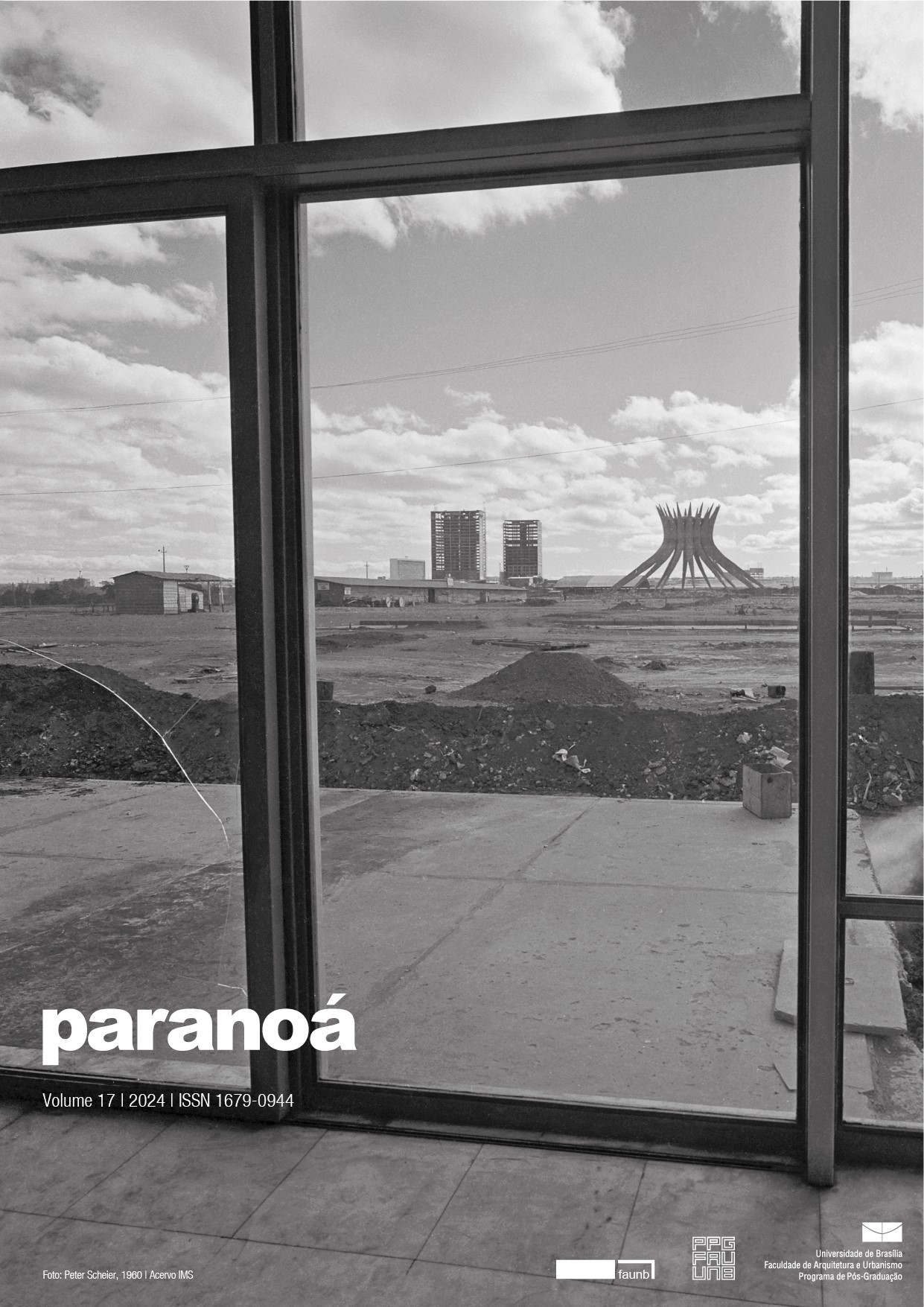Containing of flooding with green infrastructure in the city of Paranoá-DF
hydraulic-hydrological modeling
DOI:
https://doi.org/10.18830/1679-09442024v17e50387Keywords:
Urban drainage, Green infrastructure, Multifunctional green corridors, SustainabilityAbstract
Planning more sustainable and resilient cities has become a major challenge, especially where dense occupations and infrastructure and environmental problems overlap. This article aims to analyze the relationship between nature and the urban environment from a network of multifunctional green corridors, focusing on the study of green infrastructure solutions applied to the stormwater drainage project of Paranoá (Federal District), in the stretch of constant flooding. After investigating the problem situation and researching the theoretical framework, simulations of two scenarios were developed (projected network and network with Low Impact Development-LID), with the PCSWMM program (ChiWater), which works with hydrological processes in urban basins. As a result, it was verified that the projected network in both scenarios is adequately sized according to the design rainfall, as no overflows were identified in the junctions. Scenario 1 presented a maximum flow compatible with the projected network and scenario 2 there was a reduction in the maximum flow in the retention of surface runoff with use of LIDs. The comparison of the scenarios demonstrated the advantages of the contribution of the green infrastructure to create integration space for the population.
Downloads
References
AHERN, J.; PELLEGRINO P.; BECKER N. Performance, Appearance, Economy, and Working Method. Universidade de Massachusetts, 2014. Disponível em: https://works.bepress.com/ahern_jack/14/.
ARAÚJO, A. S. (2018). Análise e proposição de medidas sustentáveis em drenagem urbana na região do Lago Norte - DF por meio de modelagem hidrológica-hidráulica. Monografia de Projeto Final, Departamento de Engenharia Civil e Ambiental, Universidade de Brasília, Brasília, DF, 80 p.
BENEDICT, M. A.; McMAHON; E. T. Green infrastructure: Smart conservation for the 21st century. Washington: The Conservation Fund, 2002.
BENEDICT, M. A.; McMAHON, E. T. Green Infrastructure – Linking Landscapes and Communities. Washington: Island Press, 2006.
BENINI, S. M. Infraestrutura Verde como Prática Sustentável para Subsidiar a Elaboração de Planos de Drenagem Urbana: estudo de caso da cidade de Tupã/SP. Universidade Estadual Paulista, Faculdade de Ciências e Tecnologia de Presidente Prudente, 2015. Disponível em: https://repositorio.unesp.br/bitstream/handle/11449/123900/000831443.pdf?sequence=1&isAllowed=y.
BONZI, R. S. EMERALD NECKLACE – INFRAESTRUTURA URBANA PROJETADA COMO PAISAGEM. Revista LABVERDE, [S. l.], n. 9, p. 106-127, 2015. DOI: 10.11606/issn.2179-2275.v0i9p106-127. Disponível em: https://www.revistas.usp.br/revistalabverde/article/view/84547.
COSTA, M.E.L. Monitoramento e modelagem das águas da drenagem urbana na bacia do lago Paranoá. Dissertação de Mestrado em Tecnologia Ambiental e Recursos Hídricos, Departamento de Engenharia Civil e Ambiental, Universidade de Brasília, Brasília, DF: UnB, 2013.
FLORIDA GREENWAYS COMMISSION, Creating a Statewide Greenways System Report. Florida, 1994. Disponível em: https://floridadep.gov/sites/default/files/1994 FloridaGreenwaysCommissionPlan.pdf.
FORMAN, R. T.; GODRON, M. Landscape ecology. New York: John Wiley & Sons, 1986. 619p.
FORMAN, R. T. Land Mosaics: The Ecology of Landscapes and Regions. Cambridge/New York: Cambridge University Press, 1995.
GOVERNO DO DISTRITO FEDERAL. ADASA. Resolução n° 09 de 8 de abril de 2011. Disponível em: https://www.sinj.df.gov.br/sinj/Diario/ee6e96ed-4811-3515-aa63-b3d37cf67a1a/d42e46d2.pdf
GOVERNO DO DISTRITO FEDERAL. CODEPLAN. Pesquisa Distrital por Amostra de Domicílio – Paranoá. Companhia de Planejamento do Distrito Federal, 2018. Disponível em: https://www.codeplan.df.gov.br/wp-content/uploads/2020/06/Parano%C3%A1.pdf.
GOVERNO DO DISTRITO FEDERAL. Lei Complementar nº 803, de 25 de abril de 2009. Aprova a revisão do Plano Diretor de Ordenamento Territorial do Distrito Federal – PDOT e dá outras providências. Disponível em: https://www.sinj.df.gov.br/sinj/Norma/60298/Lei_Complementar_803_25_04_2009.html.
GUIMARÃES, L. G. (2019). Estratégias de Infraestrutura Verde Aplicadas à Drenagem Urbana em Áreas Densamente Ocupadas: O Caso do Trecho 3 do Setor Habitacional Sol Nascente. Dissertação de Mestrado em Tecnologia Ambiental e Recursos Hídricos, Publicação PTARH. DM – 229/2019, Departamento de Engenharia Civil e Ambiental, Universidade de Brasília, Brasília, DF, 112p.
HERZOG, C. P.; ROSA, L. Z. Infraestrutura Verde: Sustentabilidade e resiliência para a paisagem urbana. Revista LABVERDE, [S. l.], n. 1, p. 92-115, 2010. DOI: 10.11606/issn.2179-2275.v0i1p92-115. Disponível em: https://www.revistas.usp.br/revistalabverde/article/view/61281.
PELLEGRINO P.; COMIER, N. S. Infraestrutura Verde: uma estratégia paisagística para a água urbana. Paisagem Ambiente: ensaios - n. 25 - São Paulo – 2008. Disponível em: http://www.espiral.fau.usp.br/arquivos-artigos/2008-Nate&Paulo.pdf.
POLIDORI, M. C. Crescimento urbano e ambiente: um estudo exploratório sobre as transformações e o futuro da cidade. Tese (Doutorado em Ecologia), Universidade Federal do Rio Grande do Sul, Porto Alegre, 2005.
TUCCI, C.E.M. (2008) Águas urbanas. Estudos Avançados, v. 22, n. 63, p. 97-112.
TUCCI, C.E.M. Hidrologia: Ciência e Aplicação. 4. ed. 7ª reimp. Porto Alegre: UFRGS/ABRH, 2015.
RENNÓ, C. D.; SOARES, J. V. Modelos Hidrológicos para Gestão Ambiental. Programa de Ciência e Tecnologia para Gestão de Ecossistemas, Ação "Métodos, modelos e geoinformação para a gestão ambiental”, INPE, 2000.
VASCONCELLOS, A. Infraestrutura verde aplicada ao planejamento da ocupação urbana na Bacia ambiental do Córrego D´Antas, Nova Friburgo – RJ. Pontifícia Universidade Católica do Rio de Janeiro, Departamento de Engenharia Civil, Rio de Janeiro-RJ, 2011.
Downloads
Published
How to Cite
Issue
Section
License
Copyright (c) 2024 Paranoá

This work is licensed under a Creative Commons Attribution 4.0 International License.
Autores que publicam nesta revista concordam com os seguintes termos:
- Autores mantém os direitos autorais e concedem à revista o direito de primeira publicação, com o trabalho simultaneamente licenciado sob a Licença Creative Commons Attribution que permite o compartilhamento do trabalho com reconhecimento da autoria e publicação inicial nesta revista. http://creativecommons.org/licenses/by/4.0
- Autores têm autorização para assumir contratos adicionais separadamente, para distribuição não-exclusiva da versão do trabalho publicada nesta revista (ex.: publicar em repositório institucional ou como capítulo de livro), com reconhecimento de autoria e publicação inicial nesta revista.
- Autores têm permissão e são estimulados a publicar e distribuir seu trabalho online (ex.: em repositórios institucionais ou na sua página pessoal) a qualquer ponto antes ou durante o processo editorial, já que isso pode gerar alterações produtivas, bem como aumentar o impacto e a citação do trabalho publicado (Veja O Efeito do Acesso Livre).















